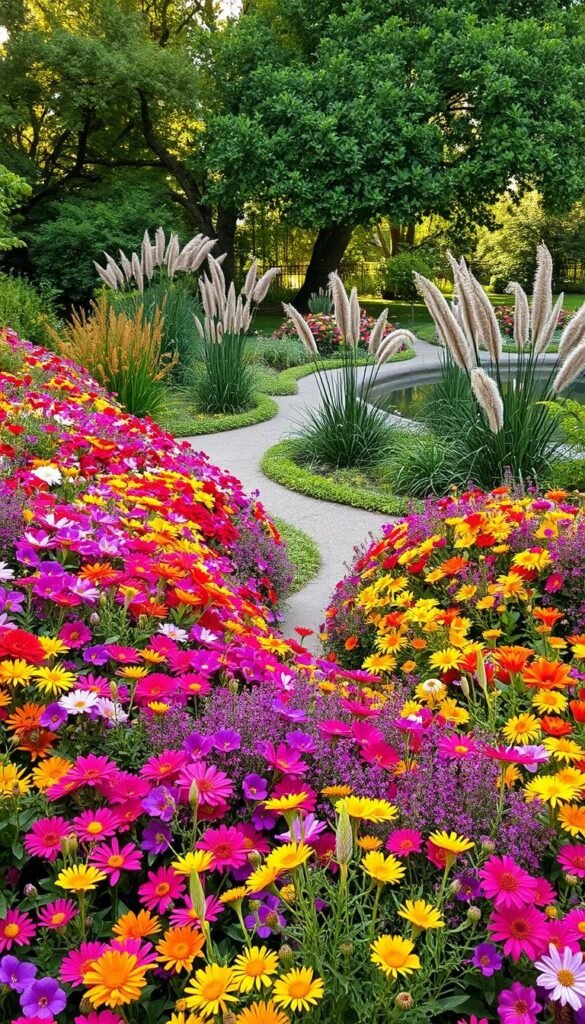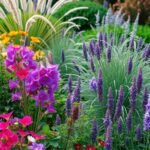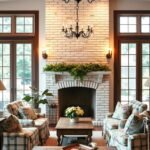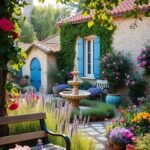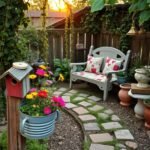Imagine stepping into a vibrant retreat right outside your door. Whether you’re working with a cozy balcony or acres of land, strategic planning turns any area into a living masterpiece. Start by focusing on color rhythms – early tulips in spring, summer hydrangeas in pots, and autumn mums that keep the show going.
Bright tulips give that first pop of color after winter, while movable containers let you experiment with layouts. Add structure with low hedges or decorative stones between flower beds – these breaks let your eyes rest before taking in more beauty.
Soft pinks, buttery yellows, and lavender create calming zones perfect for relaxation. For deeper impact, cluster bold hues like red geraniums or purple salvias. Want more inspiration? Explore our guide on elevating your space with textures and vertical planters.
Your personalized sanctuary will attract butterflies, bees, and moments of peace. It’s not just about plants – it’s crafting an experience that shifts with the seasons and reflects your unique style.
Setting the Stage for a Colorful Outdoor Haven
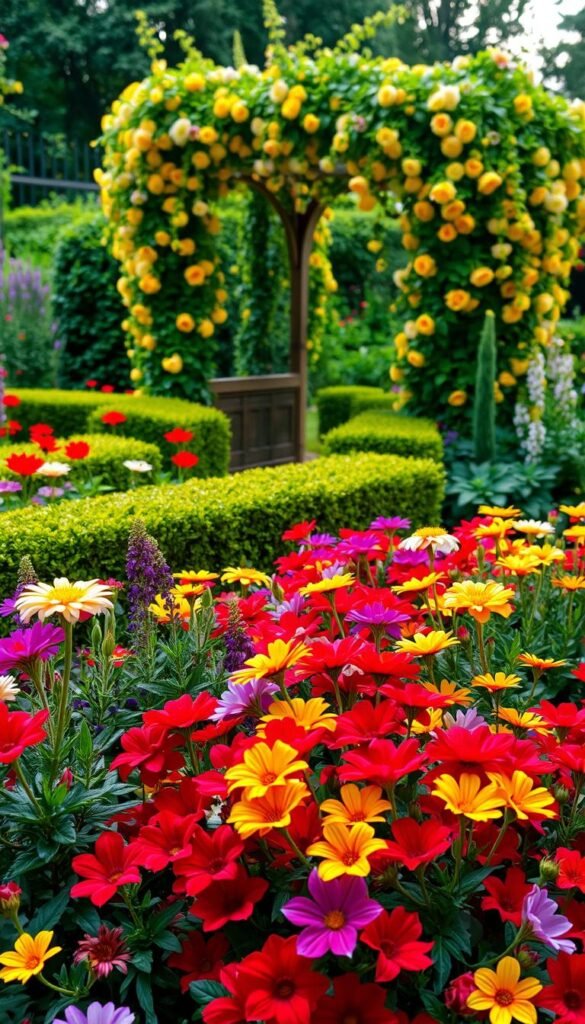
Your dream outdoor space begins with thoughtful preparation and planning. Whether you’re refreshing a small corner or redesigning an entire yard, success starts with two essentials: knowing your environment and selecting hues that sing together.
Understanding Your Space and Soil
Start by mapping sunlight patterns in your area. Watch how shadows move across your space during the day. Most blooms need 6+ hours of direct sun, while shade-loving plants thrive under trees or along north-facing walls.
Test your soil’s pH using a kit from local nurseries. Acidic soils (below 6.5) suit hydrangeas and azaleas, while alkaline earth (above 7) favors lilacs. Mix in compost to improve drainage—this simple step prevents root rot and boosts nutrient absorption.
Choosing a Harmonious Color Palette
Pick 3-4 main hues that complement your home’s exterior. Soft peaches and sky blues create serene spaces, while crimson and gold demand attention. Remember: light colors make small areas feel bigger, while deep tones add cozy intimacy.
Plan for four-season interest with this simple formula:
| Color Scheme | Best For | Mood Effect |
|---|---|---|
| Warm tones | Entryways | Energetic |
| Cool blues | Seating areas | Calming |
| Pastel mix | Path borders | Cheerful |
Rotate flowering plants to maintain color through fall. Pair early bloomers like crocuses with late stars like asters. This approach keeps your design lively from first thaw to frost.
Designing with Blooms, Shrubs, and Foliage

Transform your outdoor canvas with living textures that shift through the seasons. Strategic combinations of plants create depth while solving practical challenges like weed control and moisture retention.
Mixing Annuals with Perennials
Pair reliable perennials with vibrant annual flowers for nonstop drama. Fuchsia petunias spill over edges of established hostas, hiding bare spots while attracting pollinators. Dense planting – spacing half the recommended distance – creates lush carpets that suppress weeds naturally.
Japanese maples anchor designs with burgundy foliage that evolves from spring to fall. For seamless transitions, repeat these stars in multiple beds. Discover more seasonal combinations in our flower arrangement guide.
Layering Heights for Visual Interest
Build dimension using vertical shrubs as backdrops. Meadow rue towers behind mid-height coneflowers, while creeping thyme softens bed edges. This tiered approach guides the eye upward, making small spaces feel expansive.
Group containers of varying height near seating areas for movable color bursts. Bright geraniums in tall urns pair with trailing lobelia in low bowls – perfect for container arrangements that refresh tired corners. Remember: odd-numbered groupings feel most natural to the eye.
Fresh Flower Garden Ideas to Build a Colorful Oasis
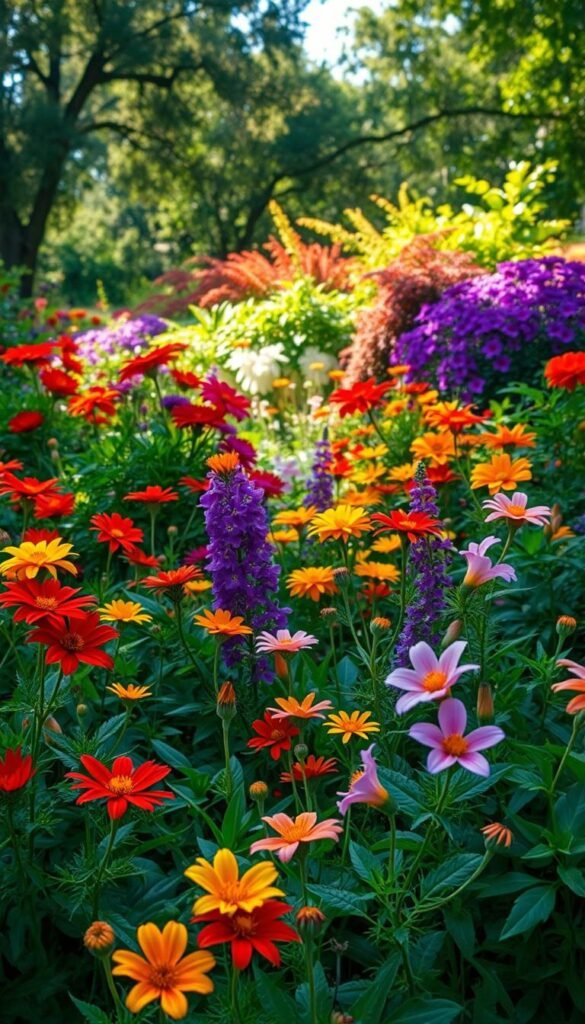
Transform your landscape into a living canvas where every hue tells a story. Bold pairings and intentional accents turn ordinary spaces into eye-catching displays that evolve daily.
Embracing Vivid Color Combinations
Break free from predictable pairings. Contrasting shades like snow-white gladiolas against crimson dahlias create electric energy. These unexpected duos make visitors pause and admire.
Sunny black-eyed Susans act as nature’s welcome signs for butterflies. Plant them in groups of five or seven—odd numbers feel organic. Larger clusters create soothing waves of color that calm the eye.
| Color Pairing | Visual Effect | Best Use |
|---|---|---|
| White + Red | High contrast drama | Entryway statements |
| Yellow + Purple | Wildlife magnet | Pollinator zones |
| Blue + Orange | Vibrant energy | Patio borders |
Creating Unforgettable Focal Points
Shape evergreens into cones or spirals for winter interest. These living sculptures anchor your design when blooms fade. Place them where paths intersect to guide movement.
Tall gladiolus spikes add vertical punch beside mounding plants. This mix of forms—upright and spreading—creates rhythm. Repeat this pattern in multiple beds to tie your space together.
Remember: your star plants need supporters. Soft ferns or silver dusty miller make bold flowers pop. This balance keeps designs exciting without overwhelming the senses.
Utilizing Containers and Decorative Planters
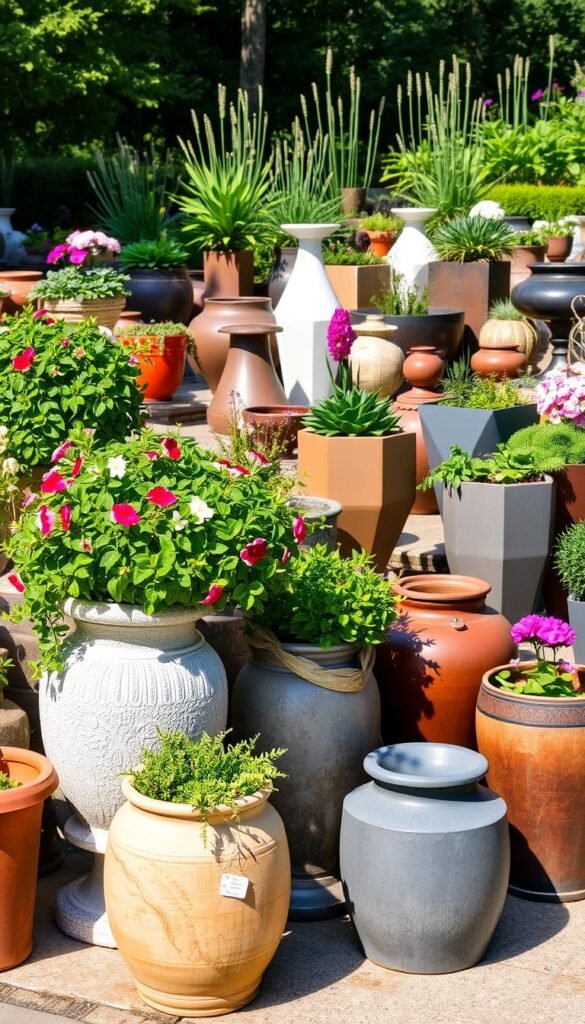
Expand your planting possibilities with vessels that combine function and artistry. Containers let you play with elevation changes and seasonal updates while solving tricky soil or space issues.
Exploring Flower Boxes, Urns, and More
Rectangular flower boxes shine on railings and ledges. Their linear shape supports trailing petunias that spill over edges like living curtains. For classic charm, pair urn-shaped planters with upright geraniums—their sculptural forms command attention on staircases or entryways.
Mix geometric shapes to create rhythm. Circular pots soften angular patios, while square designs complement modern architecture. This blend of shapes adds depth without overwhelming the space.
| Container Type | Best Plants | Visual Effect |
|---|---|---|
| Flower Boxes | Trailing petunias | Horizontal flow |
| Urns | Upright geraniums | Vertical emphasis |
| Round Pots | Dwarf sunflowers | Soft focal points |
| Square Planters | Ornamental grasses | Modern structure |
Tips for Grouping Planters Artfully
Start with a large urn as your anchor piece. Surround it with mid-sized containers holding complementary colors, leaving space for small accent pots. This tiered arrangement guides the eye naturally across your display.
For container groupings that pop, combine different materials. Glazed ceramic pairs beautifully with weathered terra-cotta, creating tactile interest. Remember these key strategies:
- Rotate pots seasonally using our patio container gardening tips
- Use saucers to protect surfaces while allowing drainage
- Elevate smaller pots on stands to vary heights
With smart combinations, your container collection becomes a movable feast of colors and textures that refresh your space all year.
Enhancing Your Garden with Hardscape Elements
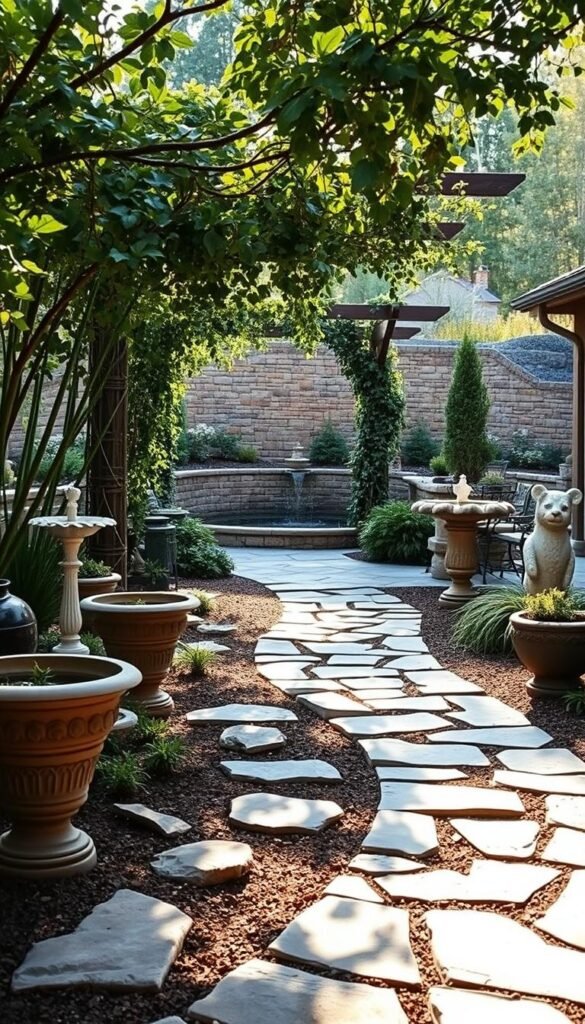
Balance soft blooms with solid forms to create an outdoor space that works as hard as it shines. Thoughtful placement of non-living features brings rhythm to your design while solving practical needs like navigation and erosion control.
Paths, Seating, and Vertical Accents
Guide foot traffic with materials that match your style. Circular stepping stones create playful pathways through wildflower patches, while crushed granite suits rustic themes. Wider walkways using rectangular pavers allow two people to stroll side by side comfortably.
Position benches where views shine brightest—near flowering shrubs or water features. A weathered teak seat under a whimsical cottage charm trellis becomes an instant focal point. These resting spots invite visitors to pause and soak in your handiwork.
Vertical structures solve multiple challenges. Purple-painted trellises define boundaries while supporting climbing roses. Tall birdhouses add height variation and shelter for feathered friends. For open areas, low fences break up expansive flower beds without blocking sightlines.
| Element | Function | Style Match |
|---|---|---|
| Gravel paths | Casual navigation | Natural gardens |
| Metal benches | Modern seating | Urban spaces |
| Wooden arbors | Shade creation | Traditional designs |
Choose materials that echo your home’s architecture—brick edging for colonial houses, smooth concrete for contemporary spaces. This harmony makes your entire landscape feel intentional and polished.
Crafting Inviting Outdoor Living Spaces
Turn overlooked corners into cherished retreats by blending structure and nature. Pergolas draped in wisteria vines transform blank slates into shaded sanctuaries, while lattice panels on gazebos filter sunlight into dappled patterns. These built elements create destination spots that invite lingering.
Designing Relaxation Spots with Gazebos and Pergolas
Define intimate spaces using overhead structures that frame your landscape. A cedar pergola with climbing roses becomes a living ceiling, while a gazebo nestled among hydrangeas offers private respite. These features carve out distinct areas within your larger layout without feeling disconnected.
Position seating to capture morning light or evening breezes. A bench facing west catches golden hour glows through flowering vines. For afternoon shade, place chairs under pergola rafters spaced 16 inches apart—enough sun penetration for nearby container herbs.
| Structure | Best Plants | Seasonal Benefit |
|---|---|---|
| Pergolas | Clematis, jasmine | Summer shade |
| Gazebos | Climbing hydrangea | Year-round structure |
Boost comfort with weatherproof cushions in sunset hues that echo your blooms. Add side tables for lemonade pitchers or garden books—practical touches that encourage longer stays. For hidden retreats, train ivy along gazebo walls to soften edges and buffer winds.
Your design gains depth when structures work double duty. Pergola beams support hanging ferns, while gazebo railings showcase trailing lobelia. Surround these spots with fragrant lavender or rosemary to engage multiple senses—color, scent, and texture working in harmony.
Innovative Garden Pathways and Edges
Shape your garden’s personality through the flow of its walkways and borders. Cleverly designed paths do more than guide footsteps—they frame views and highlight your favorite blooms. Meanwhile, thoughtful edges create polished transitions between lush plantings and open spaces.
Curved Paths and Gravel Walkways
Meandering gravel trails add relaxed charm to casual landscapes. Their soft crunch underfoot creates soothing rhythms while allowing rainwater to drain quickly. Curves feel more inviting than straight lines, encouraging visitors to slow down and enjoy the journey.
Pair these winding paths with undulating borders that mirror their shape. Miniature boxwood hedges make elegant edges, preventing grass from creeping into flower beds. For cottage-style spaces, let creeping thyme spill over stone borders—it releases fragrance when brushed against.
| Material | Style Match | Maintenance Tip |
|---|---|---|
| Pea gravel | Rustic designs | Rake annually |
| Stepping stones | Modern layouts | Level with sand base |
| Mulch | Woodland areas | Refresh every spring |
Use pathways to create delightful surprises. A bend might reveal a hidden bench surrounded by lavender. Wider sections can showcase potted geraniums or ornamental grasses. These elements turn practical ways through your space into memorable experiences.
Maximizing Vertical Space with Wall and Railing Planters
Elevate your greenery game by looking upward—walls and railings offer untapped potential for lush displays. Vertical gardening solves space constraints while adding visual drama to blank surfaces. Lightweight fiberglass planters (15-20 lbs) protect structures while holding vibrant plants.
Creating Statements with Wall-Mounted Gardens
Turn bare walls into living art with modular pocket planters. Mix spiky succulents with trailing ivy for texture contrast. South-facing spots? Try sun-loving petunias in recycled tin cans for pops of color that defy gravity.
Railings become instant gardening zones with clamp-on boxes. Grow herbs like basil or mint within arm’s reach. For north-facing areas, shade-tolerant ferns thrive in self-watering pots—ideal for apartment dwellers without outdoor water access.
Vary height using tiered shelves. Tall ornamental grasses add movement, while cascading lobelia softens edges. This approach maximizes every inch, transforming cramped areas into thriving green retreats.

